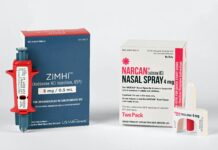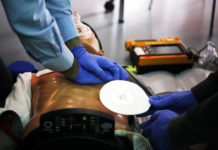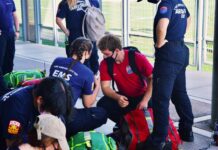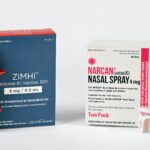Abstract
Background: Nausea is a common chief complaint in the prehospital setting, and collegiate-based emergency medical services (CBEMS) providers frequently encounter nausea secondary to alcohol intoxication. Objectives: We hypothesized that high variability would be present in statewide protocols at all prehospital provider levels, limiting the use of these therapies in particular for CBEMS organizations operating at the BLS level. Methods: A cross-sectional analysis of publicly available statewide emergency medical services (EMS) protocols was completed in October 2018 and updated in August 2019 examining presence of antiemetic therapies at each provider level. The licensure levels of CBEMS organizations affiliated with the National Collegiate Emergency Medical Services Foundation (NCEMSF) within each state were obtained from the NCEMSF Organization Database. Results: We identified 33 publicly available model or mandatory statewide EMS protocols which contained an antiemetic protocol/therapy. Of these, five (15.2%) included antiemetic therapies at the basic life support (BLS) level. In addition, 256 NCEMSF-affiliated CBEMS agencies were identified, of which 162 operate at the BLS level. Eight BLS organizations (4.9%) operate in states with statewide protocols that include a BLS therapy for nausea. Conclusions: CBEMS agencies face wide variation in BLS-level nausea therapies depending on statewide protocols. Oral dissolving ondansetron remains largely restricted to the advanced life support (ALS) level. Further research should assess the effectiveness of these therapies in the BLS-level prehospital scope-of-practice.
Introduction
In the United States, nausea is the chief complaint in up to five million ED visits annually.1 In the prehospital setting, nausea with and without vomiting occurs in up to 10% of patients.2 Nausea may result from a gastrointestinal syndrome, but may also occur secondary to trauma, cardiogenic causes, or – of particular relevance in the college or university setting – the use of alcohol and other drugs.3,4 Nausea and vomiting are distressing to patients and present the risk of aspiration.2
Ondansetron (marketed under the brand name Zofran) is routinely used as an antiemetic treatment to relieve nausea and prevent vomiting. Several formulations are available, including oral (PO), oral dissolving tablets (ODT), intravenous (IV), and intramuscular (IM). Studies suggest that ondansetron can be safely and effectively administered by prehospital providers at the advanced life support (ALS) level via IV, IM, and oral routes.5–8 However, there is a lack of literature on the administration of ondansetron by providers at the basic life support (BLS) level.
Nausea and vomiting may also be managed with pharmaceuticals such as metoclopramide as well as noninvasive treatments including isopropyl alcohol aromatherapy and P6 acupressure. Isopropyl alcohol aromatherapy is a nausea treatment in which patients nasally inhale isopropyl alcohol, typically through pads soaked in isopropyl alcohol. Some studies have demonstrated efficacy of isopropyl alcohol aromatherapy for nausea treatment in the ED9,10 but other studies of postoperative nausea suggest that isopropyl alcohol aromatherapy with ondansetron does not provide benefit over ondansetron alone.11 An ongoing clinical trial is investigating the administration of isopropyl alcohol aromatherapy in the prehospital setting by providers at the ALS level.12
Another noninvasive antiemetic therapy is P6 acupressure, which draws its roots from traditional Chinese acupuncture. The treatment involves the application of pressure to the P6 acupressure point, located approximately three finger-widths from the wrist in the middle of the forearm. However, the efficacy of P6 acupressure in the medical setting is an area of debate. One randomized control trial (RCT) suggested short-term nausea relief in post-operative thyroidectomy,13 although two other RCTs regarding post-operative nausea in laparoscopic cholecystectomy and craniotomy both suggested no significant difference between P6 acupressure and a control.9,10 However, no studies have tested the effectiveness of P6 acupressure in the prehospital setting.
In the United States, the treatment options available to prehospital providers are dictated by written protocols as well as on-line or off-line orders from medical direction. States may create mandatory protocols that must be followed by all EMS providers in the state or model protocols which regional or local authorities may choose to adopt.14 The development of statewide protocols is often informed by the National EMS Model Guidelines, produced by the National Association of EMS Officials.15 Although many states do not rely on mandatory or model statewide protocols,14 statewide protocols provide an indicator of available therapeutic options and current practices.
Objectives
We sought to characterize the variability across statewide protocols of the prehospital management of nausea at the BLS level. As a secondary aim, we sought to determine the number of BLS-level CBEMS organizations in states with BLS protocols that include antiemetic therapy.
Methods
A cross-sectional analysis of publicly available statewide EMS protocols was completed in October 201816 and updated in August 2019. State Department of Health websites as well as Google searches were utilized to identify publicly available statewide EMS protocols (Alphabet Inc, Menlo Park, CA, USA). Search terms included each state name (including Washington, DC) followed by “EMS protocols”; for example, the first search term was “Alabama EMS protocols.” In addition, a list of protocols in a previously published analysis of statewide protocols by Kupas et al. (2015) was reviewed.14 Both model and mandatory state protocols, as defined by Kupas et al. (2015), were included for analysis. We also reviewed the National Model EMS Guidelines.15 For data abstraction, state licensure levels were defined as:
- Basic Life Support (BLS): Emergency Medical Technician (EMT)
- Intermediate Life Support (ILS): Advanced Emergency Medical Technician (AEMT)
- Advanced Life Support (ALS): Paramedic
All states with protocols for nausea management or antiemetic therapies (including in protocols for pain comfort/management) were included for analysis, provided the protocols had been published within the last 10 years. The following data was abstracted from statewide protocols:
- Presence of statewide protocol for nausea/vomiting management.
- Antiemetic therapies at provider level (BLS, ILS, and ALS), with PO and ODT ondansetron defined as an outcome of interest. Other outcomes of interest included alternative antiemetic therapies such as isopropyl alcohol aromatherapy or P6 acupressure.
- Presence of medical alternatives to ondansetron (metoclopramide, promethazine, etc.).
The publicly available National Collegiate EMS Foundation (NCEMSF) Organization Database was reviewed in October 2018 to identify all CBEMS organizations registered with NCEMSF.17 For all states with publicly available statewide nausea or antiemetic therapy protocols, we recorded the number of agencies and each agency’s licensure level as categorized in the NCEMSF Organization Database: First Responder, Basic Life Support, Intermediate Life Support, or Advanced Life Support. Two trained reviewers (C.C., I.M.) independently collected data from statewide protocols using standardized abstraction forms; interrater reliability was assessed using Cohen’s κ and any discrepancies were resolved by the senior author (T.M.). Descriptive statistics were generated using R v3.3.2 (The R Foundation for Statistical Computing, 2018).
Results
We identified 34 states (including Washington, DC) with publicly available model or mandatory statewide protocols published within the past 10 years. Of the 34 states, 33 include protocols for prehospital nausea management or antiemetic therapies (Figure 1). Compared to previous literature which excluded 12 states from analysis,14 our study excluded 17 states from analysis and included the District of Columbia. With respect to the five states included by Kupas et al. (2015) that we did not analyze,14 Illinois and Alaska no longer have their statewide protocols publicly available; Nevada no longer has statewide protocols; California delegates protocol development to local authorities; and Washington state has not updated their online protocols since 2005. Montana has a publicly available statewide protocol, but delegates development of nausea protocols to local EMS authorities. Of note, Minnesota only provided BLS protocols and ALS protocols for pediatrics, while South Dakota only provided BLS protocols. We abstracted data on antiemetic therapies from protocols for nausea management, patient comfort, or pain management with κ = 1.
Of the 33 states with statewide protocols for prehospital nausea management, 5 (15.2%) contain protocols at the BLS level. Two states permit administration of ODT ondansetron (West Virginia, Delaware), one permits the use of isopropyl alcohol aromatherapy (New Hampshire), and two permit acupressure at the P6 point through manual techniques or use of a commercial device (Maryland, New Mexico) (Figure 2). Arkansas includes ODT ondansetron in their protocol, but the protocol did not specify whether this is limited to ALS providers. We did not identify any protocols permitting use of intramuscular antiemetics at the BLS level.
Considering BLS, ILS, and ALS provider levels, 26 states (78.8%) have protocols that include ODT ondansetron, with 23 (70.0%) of these protocols restricting ODT ondansetron administration to ILS and higher-level providers. Ten states (30.3%) restrict ODT ondansetron administration exclusively to ALS providers (Figure 2).
The National Model EMS Guidelines also has a nausea protocol.15 This protocol includes both IV and ODT ondansetron but does not specify protocol scope-of-practice between various provider levels. This model protocol also includes the antiemetic alternatives of metoclopramide, prochlorperazine, diphenhydramine, and isopropyl alcohol, but does not include P6 acupressure.
In total, 256 CBEMS organizations were identified in the NCEMSF Organization Database, of which 162 (63%) operate at the BLS level (Appendix S1). Eight of the identified BLS organizations were found to operate within states that contain a BLS therapy for nausea. Two of these CBEMS organizations were in states that have statewide BLS protocols for ODT ondansetron (1 in West Virginia; 1 in Delaware); 4 were in a state with a BLS protocol for isopropyl alcohol aromatherapy (New Hampshire); and two were in a state with a BLS protocol for acupressure (Maryland).
Discussion
Our data demonstrate that the vast majority of NCEMSF-affiliated CBEMS agencies at the BLS level are unable to provide antiemetic therapy, as most states with publicly available statewide protocols do not offer a BLS therapy for nausea. Only West Virginia and Delaware currently allow BLS providers to provide ODT ondansetron. While ODT ondansetron is readily available in the formularies of most states identified within the study, most states restrict ODT ondansetron to ILS or ALS providers.
Studies suggest that ODT ondansetron is as safe and effective as IV ondansetron in the hospital postoperative setting18 as well as superior to saline in the prehospital setting.8 While evidence supports the effectiveness of ondansetron in the prehospital setting with ALS providers7,19 further research is needed on its usage among BLS providers. Of note, one prehospital paramedic-restricted study showed IV administration of ondansetron to have a stronger effect on nausea than ODT administration.5
One possible rationale for the restriction of ondansetron administration by BLS providers is the potential for adverse reactions. Ondansetron administration may lead to cardiac arrhythmias through QT prolongation,10 and thus should be used with caution among patients with congenital or acquired Long QT syndrome. BLS providers are unable to measure QT intervals with an EKG, which could lead to inappropriate administration of ondansetron for patients with comorbid factors.
CBEMS agencies are also impacted by the lack of inclusion of alternative antiemetic therapies in statewide EMS protocols. However, our study demonstrates that the rate of adoption of alternative antiemetic therapies at the BLS, ILS, or ALS provider levels remains exceedingly low in statewide protocols. In addition, disagreements over appropriate dosage of isopropyl alcohol aromatherapy have yet to be resolved. For example, one study involved three inhalations of isopropyl alcohol over four minutes,20 while New Hampshire EMS protocols suggest the same three doses over 15 minutes.21 The clinical effectiveness of P6 acupressure lacks a strong evidence base, as noted by conflicting results of studies on its use in the hospital setting12–14,18,19 and a lack of studies on its use in the prehospital setting. Further research should aim to understand appropriate dosages, pharmacodynamics, and efficacy of various antiemetic alternatives to ondansetron such as isopropyl alcohol aromatherapy and P6 acupressure. Further research should also explore the effectiveness, safety, and feasibility of their administration by BLS providers in the prehospital setting.
Limitations
Our inclusion criteria limited analysis to states with publicly available statewide protocols. This differed from previous literature regarding protocol availability and is a limitation of this study.14 Changes in protocol guidelines at both state and local levels or changes in the public availability of these protocols affected our ability to survey the same statewide protocols as previous literature.14
In addition, this study does not survey the “protocol of practice” or lex terrae. Many states rely on regional, county, or system-based EMS protocols in the absence of or in conjunction with statewide guidelines. This means that it is possible that implementation and adherence to statewide protocols may vary drastically between individual EMS systems. This effect is likely to be especially pronounced in states with model statewide protocols, where local EMS protocols may vary from the published model. Since we did not survey NCEMSF-affiliated agencies to assess their adherence to statewide protocols, it is possible that prehospital antiemetic therapies are used more or less frequently than recommended in statewide protocols. Therefore, this study was not able to directly measure the prevalence of prehospital nausea management.
Conclusions
This cross-sectional analysis of statewide EMS protocols demonstrates that the majority of CBEMS agencies operate in geographic areas where statewide protocols do not allow antiemetic therapies at the BLS level. However, a few select states have implemented protocols using ODT ondansetron, isopropyl alcohol aromatherapy, or P6 acupressure to provide antiemetic therapies at the BLS level prehospitally. Further research should assess the effectiveness and safety of ODT ondansetron and alternative antiemetic therapies as BLS interventions in collegiate EMS settings. States should consider the pros and cons of expanding their BLS nausea protocols during future updates.
References
- Myer PA, Mannalithara A, Singh G, Singh G, Pasricha PJ, Ladabaum U. Clinical and Economic Burden of Emergency Department Visits Due to Gastrointestinal Diseases in the United States. Am J Gastroenterol. 2013;108(9):1496-1507. https://doi.org/10.1038/ajg.2013.199
- Easton R, Bendinelli C, Sisak K, Enninghorst N, Balogh Z. Prehospital nausea and vomiting after trauma: Prevalence, risk factors, and development of a predictive scoring system. J Trauma Acute Care Surg. 2012;72(5):1249-1253; discussion 1253-1254. https://doi.org/10.1097/TA.0b013e318249668e
- Parashette KR, Croffie J. Vomiting. Pediatr Rev. 2013;34(7):307-321. https://doi.org/10.1542/pir.34-7-307
- Metz A, Hebbard G. Nausea and vomiting in adults–a diagnostic approach. Aust Fam Physician. 2007;36(9):688-692.
- Salvucci AA, Squire B, Burdick M, Luoto M, Brazzel D, Vaezazizi R. Ondansetron is safe and effective for prehospital treatment of nausea and vomiting by paramedics. Prehosp Emerg Care. 2011;15(1):34-38. https://doi.org/10.3109/10903127.2010.519822
- Abouleish EI, Rashid S, Haque S, Giezentanner A, Joynton P, Chuang AZ. Ondansetron versus placebo for the control of nausea and vomiting during Caesarean section under spinal anaesthesia. Anaesthesia. 1999;54(5):479-482. https://doi.org/10.1046/j.1365-2044.1999.00798.x
- Benner JP, Ferguson JD, Judkins AE, O’Connor RE, Brady WJ. Ondansetron as an effective antiemetic in the rural, out-of-hospital setting. Am J Emerg Med. 2011;29(7):818-821. https://doi.org/10.1016/j.ajem.2011.03.022
- Fullerton L, Weiss SJ, Froman P, Oglesbee S, Cheney P. Ondansetron oral dissolving tablets are superior to normal saline alone for prehospital nausea. Prehosp Emerg Care. 2012;16(4):463-468. https://doi.org/10.3109/10903127.2012.695430
- Yilmaz Sahin S, Iyigun E, Can MF. Effect of acupressure application to the P6 acupoint before laparoscopic cholecystectomy on postoperative nausea-vomiting: A randomized controlled clinical study. Int J Nurs Stud. 2018;87:40-48. https://doi.org/10.1016/j.ijnurstu.2018.07.011
- Nilsson I, Karlsson A, Lindgren L, Bergenheim T, Koskinen L-O, Nilsson U. The efficacy of P6 acupressure with sea-band in reducing postoperative nausea and vomiting in patients undergoing craniotomy: a randomized, double-blinded, placebo-controlled study. J Neurosurg Anesthesiol. 2015;27(1):42-50. https://doi.org/10.1097/ANA.0000000000000089
- Radford KD, Fuller TN, Bushey B, Daniel C, Pellegrini JE. Prophylactic isopropyl alcohol inhalation and intravenous ondansetron versus ondansetron alone in the prevention of postoperative nausea and vomiting in high-risk patients. AANA J. 2011;79(4 Suppl):S69-74.
- EMS Use of Isopropyl Alcohol Aromatherapy Versus Ondansetron – Full Text View – ClinicalTrials.gov. https://clinicaltrials.gov/ct2/show/NCT02618343. Published December 1, 2015. Updated April 2, 2019. Accessed February 5, 2020.
- Kwon J-H, Shin Y, Juon H-S. Effects of Nei-Guan (P6) Acupressure Wristband: On Nausea, Vomiting, and Retching in Women After Thyroidectomy. Cancer Nurs. 2016;39(1):61-66. https://doi.org/10.1097/NCC.0000000000000243
- Kupas DF, Schenk E, Sholl JM, Kamin R. Characteristics of statewide protocols for emergency medical services in the United States. Prehosp Emerg Care. 2015;19(2):292-301. https://doi.org/10.3109/10903127.2014.964891
- Medical Directors Council, National Association of State EMS Officials National Model EMS Clinical Guidelines: Version 2.2. https://nasemso.org/projects/model-ems-clinical-guidelines/. Published January 2019. Accessed January 28, 2020.
- Chuck CC, Martin NTJ, Moseley IH, Ranney ML, Asselin. No IV, No Problem: A Cross Sectional Analysis of Antiemetic Therapies in Statewide EMS Protocols. J Coll Emerg Med Serv. 2019;2(S1):S4. https://doi.org/10.30542/JCEMS.2019.02.S1.04
- National Collegiate Emergency Medical Services Foundation EMS Organization Database. https://www.ncemsf.org/resources/ems-organization-database/groups-listed-by-region. Accessed February 5, 2020.
- Fox-Geiman MP, Fisher SG, Kiley K, Fletcher-Gonzalez D, Porter N, Stiff P. Double-blind comparative trial of oral ondansetron versus oral granisetron versus IV ondansetron in the prevention of nausea and vomiting associated with highly emetogenic preparative regimens prior to stem cell transplantation. Biol Blood Marrow Transplant. 2001;7(11):596-603. https://doi.org/10.1053/bbmt.2001.v7.pm11760147
- Moffett PM, Cartwright L, Grossart EA, O’Keefe D, Kang CS. Intravenous Ondansetron and the QT Interval in Adult Emergency Department Patients: An Observational Study. Acad Emerg Med. 2016;23(1):102-105. https://doi.org/10.1111/acem.12836
- Beadle KL, Helbling AR, Love SL, April MD, Hunter CJ. Isopropyl Alcohol Nasal Inhalation for Nausea in the Emergency Department: A Randomized Controlled Trial. Ann Emerg Med. 2016;68(1):1-9.e1. https://doi.org/10.1016/j.annemergmed.2015.09.031
- Division of Fire Standards and Training & Emergency Medical Services, New Hampshire Department of Safety. Patient Care Protocols, Version 7.1. https://www.nh.gov/safety/divisions/fstems/ems/advlifesup/patientcare.html. Published April 2018. Accessed February 7, 2020.
Supplementary Materials
Appendix S1: Table – Number of NCEMSF agencies in states included in analysis, by state and responder level











